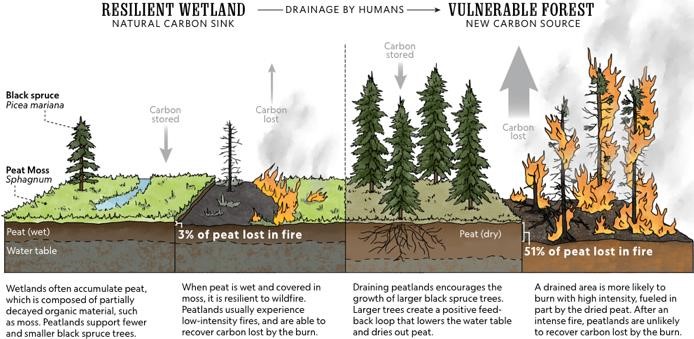6.4 Peatland Wildfires
Global climatic and environmental conditions are testing the limits of peatlands to regulate their hydrological and biogeochemical functions; the cumulative impacts of disturbance on peatlands suggests these long-term ecosystem functions are at a tipping point. Of particular concern are the impacts of peatland wildfires—not only on the hydrological function of peatlands but also the negative impacts to environmental and human health. Under the warming climate, wildfires in peatland dominated landscapes are likely to increase, as peatlands are expected to become drier (Helbig et al., 2020). The susceptibility to fire is similar to that associated with drainage or dewatering associated with human activity (Figure 22).

Figure 22 – The high water table in undisturbed peatlands provides a measure of protection against wildfire. While the surface may burn, the low intensity of the fire leaves sufficient nearby seeds and diaspores and a substrate more suitable for recolonization of typical peatland plants. Deeper water tables associated with drainage, dewatering, or climate warming intensify the severity of wildfire burns, consuming much of the peat deposit, and leaving the area devoid of viable genetic material to recolonize the surface—and with substrate properties entirely different than pre-burn (Graphic from Ebein, 2019 based on data from Wilkinson et al., 2018).
In addition to the large carbon loss associated with severe burns, the thickness of the remaining peat and the hydraulic character of the soil profile alters the groundwater regime and thus the function of any future recovered ecosystem. It is critical to understand the interactions between peatland wildfires and changes to peatland hydrology to better adapt to this growing disturbance.
Immediately after a peatland wildfire, several key changes to the physical and hydrological processes impact water flow. Changes to the physical and chemical structure of the peat from fires plays a critical role in what, and how much, percolates to the water table. As peat dries during combustion, the organic molecules become hydrophobic (Moore et al., 2017), reducing the volume of water percolating into the peatland through smaller diameter pore throats.
The degree of hydrophobicity is linked to not only the botanical origin of the peat but also the length and degree of heating, thus fire severity (Wilkinson et al., 2020). These changes result in a greater proportion of overland and near surface runoff being generated from burned peatlands (Sherwood et al., 2013) rather than by groundwater flow. However, the large proportion of macropores in the upper peat matrix can allow for rapid bypass flow from the surface to deeper, non-hydrophobic peats. Thus, the specific post-fire peat pore structure partly governs the total proportion of water that recharges the peatland aquifer. As some percolation occurs, the fine-grained ash particles are downwardly mobilized, increasing peat bulk density (Elmes et al., 2019), thus lowering saturated hydraulic conductivity (Ackley et al., 2021) and specific yield (Sherwood et al., 2013).
The loss of vascular vegetation following fire may reduce transpiration, leading to an increase in the water table height, increasing the transmissivity of the peat profile, and enhancing subsurface runoff from burned peatlands (Morison et al., 2020). However, increases in evaporation mediated by reduced shading have been found to partly offset reductions in transpiration and can lead to lower water tables (Thompson et al., 2014). In either case, reduced buffering of hydrological inputs and outputs caused by removing surface vegetation and ground cover may be exacerbated by the lower specific yield, driving greater water table variability. Concurrently, as the peatland vascular and bryophyte vegetation recovers from the fire, there are subsequent feedbacks to peatland hydrology driven by changes in atmospheric water exchange. As peatland vegetation returns after fire, the water table decreases due to increased evapotranspiration from both the vascular vegetation; the return of hydrophilic soils increases that connectivity of the peatland surface to the water table. It is not only the direct impacts of wildfires on peatland hydrology, but also the evolution of this particular disturbance over time and the compounding effects of climate change that makes peatland wildfires a particularly insidious hydrological disturbance.
